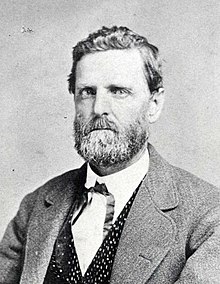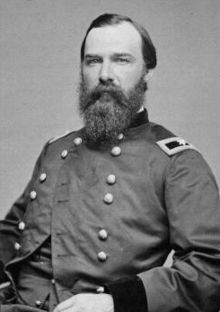
Morristown is a city in and the county seat of Hamblen County, Tennessee, United States. Morristown also extends into Jefferson County on the western and southern ends. The city lies within the Ridge and Valley region of the Appalachians, along Cherokee Lake on the Holston River. The city's population was recorded to be 30,431 at the 2020 United States census. It is the principal city of the Morristown Metropolitan Statistical Area, which encompasses all of Grainger, Hamblen, and Jefferson counties. The Morristown metropolitan area is also part of the Knoxville-Morristown-Sevierville Combined Statistical Area.
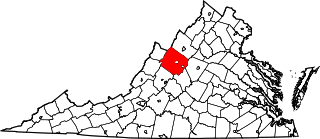
The Battle of Piedmont was fought June 5, 1864, in the village of Piedmont, Augusta County, Virginia. Union Maj. Gen. David Hunter engaged Confederates under Brig. Gen. William E. "Grumble" Jones north of Piedmont. After severe fighting, Jones was killed and the Confederates were routed. Hunter occupied Staunton on June 6 and soon began to advance on Lynchburg, destroying military stores and public property in his wake.

The Battle of Stones River, also known as the Second Battle of Murfreesboro, was fought from December 31, 1862, to January 2, 1863, in Middle Tennessee, as the culmination of the Stones River Campaign in the Western Theater of the American Civil War. Of the major battles of the war, Stones River had the highest percentage of casualties on both sides. The battle ended in Union victory after the Confederate army's withdrawal on January 3, largely due to a series of tactical miscalculations by Confederate Gen. Braxton Bragg, but the victory was costly for the Union army. Nevertheless, it was an important victory for the Union because it provided a much-needed boost in morale after the Union's recent defeat at Fredericksburg and also reinforced President Abraham Lincoln's foundation for issuing the Emancipation Proclamation, which ultimately discouraged European powers from intervening on the Confederacy's behalf.
The Battle of Devil's Backbone, also known as the Action at Devil's Backbone, was a military engagement in the Trans-Mississippi Theater of the American Civil War. Devil's Backbone is a ridge in the Ouachita Mountains approximately 4 miles (6.4 km) southwest of Greenwood, Arkansas. The battle was fought on September 1, 1863, in Sebastian County, Arkansas. The Union victory ensured the safety of the Fort Smith garrison until the end of the war.
The Battle of Dandridge, January 17, 1864, was a minor battle of the American Civil War that occurred in Jefferson County, Tennessee.
The Battle of Bulls Gap took place during the American Civil War from November 11 to November 13, 1864, in Hamblen County and Greene County, Tennessee.
The First Battle of Murfreesboro was fought on July 13, 1862, in Rutherford County, Tennessee, as part of the American Civil War. Troops under Confederate cavalry commander Brig. Gen. Nathan Bedford Forrest surprised and quickly overran a Federal hospital, the camps of several small Union units, and the jail and courthouse in Murfreesboro, Tennessee. All of the Union units surrendered to Forrest, and the Confederates destroyed much of the Union's supplies and destroyed railroad track in the area. The primary consequence of the raid was the diversion of Union forces from a drive on Chattanooga.
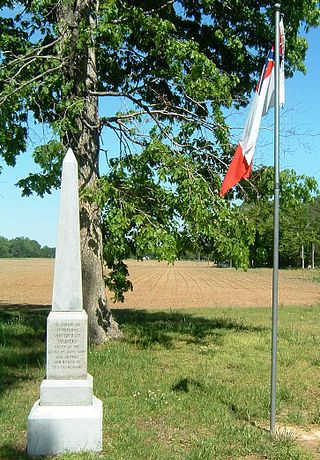
The Battle of Haw's Shop or Enon Church was fought on May 28, 1864, in Hanover County, Virginia, as part of Union Lt. Gen. Ulysses S. Grant's Overland Campaign against Confederate Gen. Robert E. Lee's Army of Northern Virginia during the American Civil War.
The Battle of Tupelo, also known as the Battle of Harrisburg, was a battle of the American Civil War fought July 14–15, 1864, near Tupelo, Mississippi. The Union victory over Confederate forces in north Mississippi ensured the safety of Sherman's supply lines during the Atlanta Campaign.

Alvan Cullem Gillem was a general in the Union Army during the American Civil War. Although Southern-born, he remained loyal to the Federal government and fought in several battles in the Western Theater before commanding occupation troops in Mississippi and Arkansas during Reconstruction. He later played a prominent role in the Modoc War in 1873.

Russellville is a census-designated place in Hamblen County, Tennessee. Located along U.S. Route 11E-Tennessee State Route 34, it is situated approximately at a midpoint between Whitesburg and Morristown.

The Battle of Marion was a military engagement fought between units of the Union Army and the Confederate Army during the American Civil War near the town of Marion, Virginia. The battle was part of Union Maj. Gen. George Stoneman's attack upon southwest Virginia, aimed at destroying Confederate industrial infrastructure near Saltville and Marion. Union Cavalry and Infantry regiments—some 4,500 soldiers in total—left Tennessee on December 17 for southwestern Virginia.
The 9th Tennessee Cavalry Regiment was a cavalry regiment that served in the Union Army during the American Civil War.

Bethesda Presbyterian Church is a historic church in Russellville, Tennessee, US, that was used as a hospital during the American Civil War. It is listed on the National Register of Historic Places.
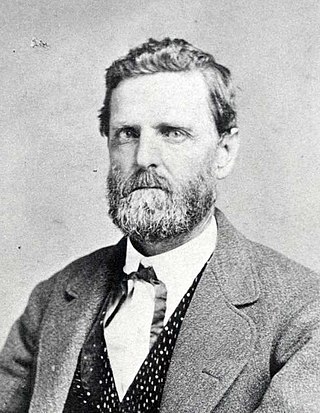
John Crawford Vaughn was a Confederate cavalry officer from East Tennessee. He served in the Mexican–American War, prospected in the California Gold Rush, and participated in American Civil War battles including First Manassas, Vicksburg, Piedmont and Saltville.

Stoneman's raid in 1865, also called Stoneman's last raid, was a military campaign in the Upper South during the American Civil War, by Union cavalry troops led by General George Stoneman, in the region of eastern Tennessee, western North Carolina and southwestern Virginia.
The Battle of Massard Prairie was fought on July 27, 1864 in Sebastian County, Arkansas during the American Civil War. Confederate troops led by Brigadier-General Richard M. Gano successfully launched a surprise attack on a Union camp held by four companies of the 6th Kansas Cavalry, capturing prisoners and equipment.

The Battle of Riggins Hill was a minor engagement in western Tennessee during the American Civil War. A Confederate raiding force under Colonel Thomas Woodward captured Clarksville, Tennessee, threatening Union shipping on the Cumberland River. Several Union regiments led by Colonel William Warren Lowe advanced from nearby Fort Donelson and drove off the Confederates after a struggle lasting less than an hour. The action occurred during the Confederate Heartland Offensive but only affected the local area.

The 24th and 25th Consolidated Texas Cavalry Regiment was a unit that originally consisted of two regiments of mounted volunteers that served in the Confederate States Army during the American Civil War. However, by the time the two regiments were consolidated, they fought as infantry. Both regiments organized as cavalry near Hempstead, Texas in April 1862 and were dismounted to fight as infantry in July 1862. The two regiments served in the same brigade and were captured at the Battle of Arkansas Post in January 1863. After being sent to Northern prison camps, the soldiers were exchanged in April 1863. Assigned to the Army of Tennessee, the two regiments were consolidated with two additional Texas cavalry regiments and in 1863 fought as infantry at Liberty Gap, Chickamauga, Missionary Ridge, and Ringgold Gap. In 1864, the other two Texas regiments were detached and the consolidated 24th and 25th fought as a separate infantry unit in the Atlanta campaign, at Franklin, and at Nashville. For the Carolinas campaign, the 24th and 25th fought at Bentonville before being reconsolidated with other Texas regiments and surrendering in April 1865.

The Battle of Philadelphia saw the Confederate cavalry brigades of Colonels J. J. Morrison and George Gibbs Dibrell attack a Union cavalry brigade under Colonel Frank Wolford at Philadelphia, Tennessee, during the Knoxville campaign of the American Civil War. While Dibrell's brigade skirmished with Wolford's cavalrymen, Morrison led his brigade around the west side of Philadelphia to attack the Union force from the rear. Wolford sent half his brigade to counter Morrison's envelopment, but Dibrell's soldiers suddenly attacked. The Confederates completely routed Wolford's troopers, capturing over 400. A Union infantry-cavalry force reoccupied Philadelphia the next day, but a week later it withdrew to the north bank of the Tennessee River, abandoning Loudon, Tennessee.

